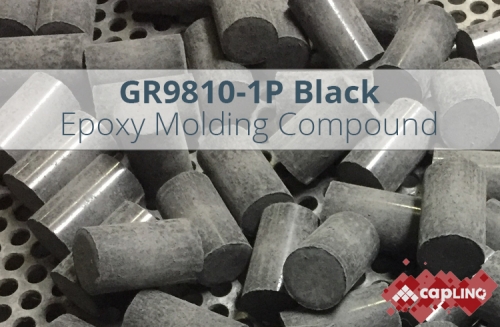Hysol KL1000-3A | Black Epoxy Mold Compound
- Lowest Cost of Ownership
- Excellent Moldability
- Designed for ZIP, SIL, DIP packages
Product Description
Hysol KL1000-3A is a black, semiconductor grade epoxy molding compound. It provides the lowest cost of ownership for an epoxy molding compound. It works on easy, low-end discrete semiconductor packages for companies that still use halogen-containing epoxy molding compounds.
Hysol KL1000-3A has a history that predates the acquisition of Huawei Electronics by Henkel. In 2005, Henkel formed a joint-venture with HuaweI Electronics in China to create Henkel Huawei Electronics (HHE) in Lianyungang China. HHE made low-end, halogen containing epoxy molding compounds that used Bromine or Antimony as a flame retardant. The KL1000-3A is an old product that is still made at Hysol Huawei today.
Hysol KL1000-3A is a halogen containing, legacy product that has been used for decades with great success for bridge rectifiers, PDIP and low end packages such as Zig zag In line (ZIP), Single In Line (SIL), Dual In line (DIP) and other low end semiconductor discrete Packages.
Technical Specifications
| General Properties | |
| Color Color The color | Black |
| Filler Content | 75 % |
| Specific Gravity Specific Gravity Specific gravity (SG) is the ratio of the density of a substance to the density of a reference substance; equivalently, it is the ratio of the mass of a substance to the mass of a reference substance for the same given volume. For liquids, the reference substance is almost always water (1), while for gases, it is air (1.18) at room temperature. Specific gravity is unitless. | 2.0 |
| Chemical Properties | |
| Moisture absorption | 0.20 % |
| Physical Properties | |
| Spiral Flow @ 175°C | 80 cm |
| Thermal Properties | |
| Glass Transition Temperature (Tg) Glass Transition Temperature (Tg) The glass transition temperature for organic adhesives is a temperature region where the polymers change from glassy and brittle to soft and rubbery. Increasing the temperature further continues the softening process as the viscosity drops too. Temperatures between the glass transition temperature and below the decomposition point of the adhesive are the best region for bonding. The glass-transition temperature Tg of a material characterizes the range of temperatures over which this glass transition occurs. | 165 °C |
| Thermal Conductivity Thermal Conductivity Thermal conductivity describes the ability of a material to conduct heat. It is required by power packages in order to dissipate heat and maintain stable electrical performance. Thermal conductivity units are [W/(m K)] in the SI system and [Btu/(hr ft °F)] in the Imperial system. | 1.3 W/m.K |
| UL 94 Rating UL 94 Rating Flammability rating classification. It determines how fast a material burns or extinguishes once it is ignited. HB: slow burning on a horizontal specimen; burning rate less than 76 mm/min for thickness less than 3 mm or burning stops before 100 mm V-2: burning stops within 30 seconds on a vertical specimen; drips of flaming particles are allowed. V-1: burning stops within 30 seconds on a vertical specimen; drips of particles allowed as long as they are not inflamed. V-0: burning stops within 10 seconds on a vertical specimen; drips of particles allowed as long as they are not inflamed. 5VB: burning stops within 60 seconds on a vertical specimen; no drips allowed; plaque specimens may develop a hole. 5VA: burning stops within 60 seconds on a vertical specimen; no drips allowed; plaque specimens may not develop a hole | V0 |
| Electrical Properties | |
| Volume Resistivity Volume Resistivity Volume resistivity, also called volume resistance, bulk resistance or bulk resistivity is a thickness dependent measurement of the resistivity of a material perpendicular to the plane of the surface. | 3.5x1016 Ohms⋅cm |
| Curing Conditions | |
| Transfer Pressure | 40 - 100 kg/cm2 |
| Transfer Time | 10 - 18 s |
Additional Information
Technical Specifications
Typical applications and uses of Hysol KL1000-3A | Black Epoxy Mold Compound include:
Technical Datasheets for Hysol KL1000-3A | Black Epoxy Mold CompoundTDS (English) |
Videos & Other Media
Sorry, there are no related videos at this time. |
View Blogs & Forum
CAPLINQ is different. Unlike other business to business enterprises, we encourage our customers to discuss, critique and otherwise comment on the products we offer. Get more technical information, read detailed posts, and see what customers have to say aboutHysol KL1000-3A | Black Epoxy Mold Compound on our Corporate Blog and Forum. |




